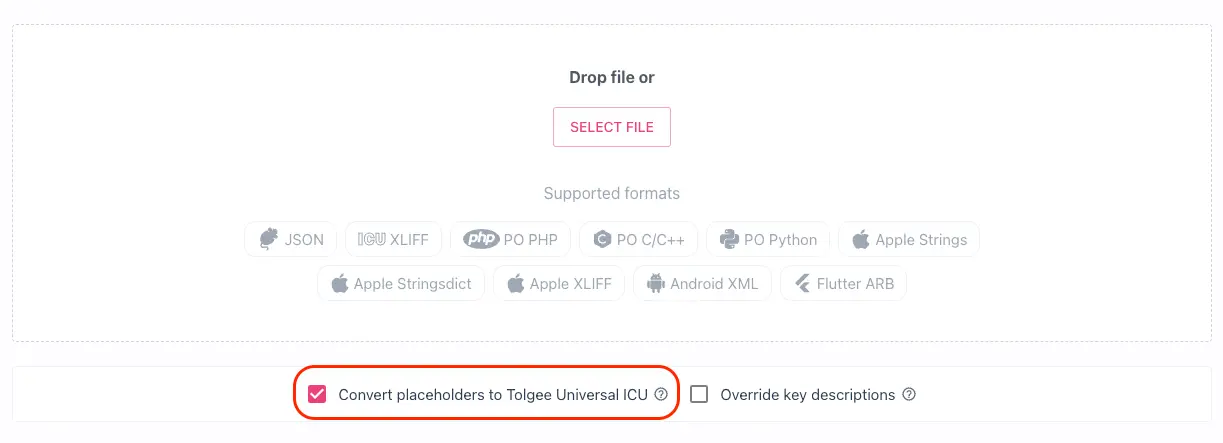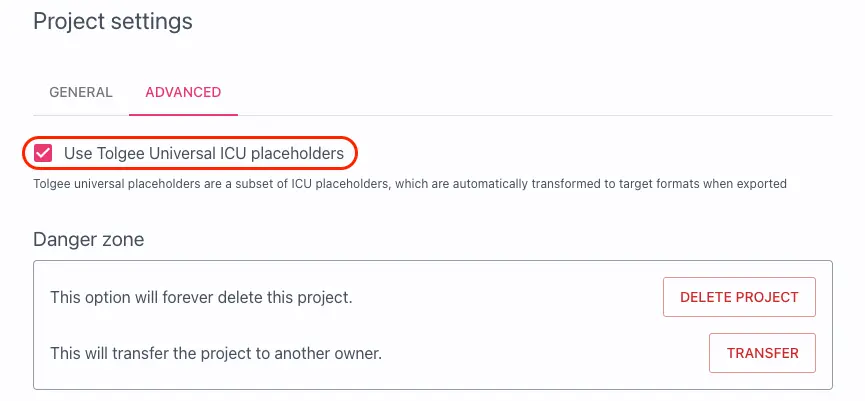Tolgee Universal ICU Placeholders
The Tolgee platform is able to convert placeholders from various formats to the ICU message format and vice versa. This concept helps you export data to different formats and get the desired formatting when using the same translations in different applications.
The Tolgee Universal ICU Placeholders are also recognized by the translation editor, and so they're visualized to provide convenient translation experience also for right-to-left languages.
Supported Placeholders
- Simple - e.g.
{0},{value}- Converted to
%sin most of the "sprintf-like" formats and into%@in Apple format.
- Converted to
- Number (Integer) - e.g.
{0, number}- Converted to
%din the most of the "sprintf-like" formats and into%lldin Apple format.
- Converted to
- Number (float) - e.g.
{0, number, 0.000000}- Converted to
%fin the most of the "sprintf-like" formats. The number of decimal places is determined by the number of0characters in the format and converted to%.nfin "sprintf-like" formats, wherenis the number of decimal places.
- Converted to
- Scientific - e.g.
{0, number, scientific}- Converted to
%ein the most of the "sprintf-like" formats
- Converted to
- # - special
replace numberplaceholder, replacing the number in the plural form. e.g.{0, plural, one {# item} other {# items}}//: # (@formatter:off)
Order and positioning
Usually, you can pass arguments into ICU message format as an array or named object/map. Sometimes, you need to swap the
order of the arguments as rendered in the result. That's why the ICU parameters are named by the zero-based index. e.g. {0}.
A similar concept exists also in "sprinf-like" formats like
PHP's sprintf or
Java Formatter class.
When exporting the zero-based indexed ICU placeholders, Tolgee will automatically convert them to the
one-based indexed for such formats, so {0} will be converted to %1$s in the "sprintf-like" formats.
Visualization of Universal ICU Placeholders
The ICU placeholders are visualized in the translation editor to provide a convenient translation experience. When Tolgee Universal ICU Placeholders are enabled at the project level; the editor will visualize the placeholders.

You can also switch the editor to the "code" mode and edit the whole message as text.

Importing
When importing translations, Tolgee will automatically convert the placeholders to the Tolgee Universal ICU Placeholders when enabled. You can find out how the placeholders are converted in the docs for the specific format.
You can control the conversion of the placeholders in the import settings by setting the Convert placeholders to Tolgee Universal ICU.

Disabling support for Universal ICU Placeholders globally
If you never want to use the Tolgee Universal ICU Placeholders, you can disable them in the project settings. In that case, Tolgee will never convert your placeholders, and the placeholders won't be visualized in the translation editor.
Also, the placeholders won't be converted when exporting. So you won't be able to export the same keys to formats with different placeholder formats.
You can find the Use Tolgee Universal ICU Placeholders setting in the Advanced tab of project settings.

Escaping
Since some characters are controlling the ICU message format, you may need to escape them. For example, to use the {
character in the translation, you will have to escape it by using the ' (apostrophe) character. e.g., What a '{' bracket.
The control characters are {, }, #, and '. The # character is only escaped if present in a plural form.
The ICU message syntax only allows us to start the escaping sequence with the apostrophe character continued by the character
to be escaped. e.g. Once you '{ start escaping { this is } all esaped. Also, the ICU Message syntax doesn't require
you to escape the apostrophe character itself. e.g. It's fine to not escape the ' apostrophe character.
However, once you're in the escaping sequence, you have to escape the apostrophe character to get it into the
formatted message. e.g., Now '{ we are escaping. It''s beatiful. { } And we are still escaping..
You can read the full documentation about the escaping in the ICU message syntax here
Escaping into the ICU might look complicated and mind-blowing, but it's indeed an edge case when you need to escape something. It was designed to require the user to escape as little as possible.
Escaping in the plural forms
Tolgee uses ICU to store the Plural forms (even when Tolgee Universal ICU Placeholders are disabled on the project level). Because of this, it always requires closed escape sequences in the plural forms; otherwise, it would break the plural representation. Because of this, it automatically closes the escape sequence in the plural forms.
For example, when you store # dogs here '{ that was a curly brace as plural, it will be saved as
# dogs here '{ that was a curly brace'.
However, this change won't affect the way how these messages will be rendered, so you don't have to worry about it.